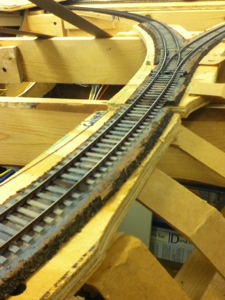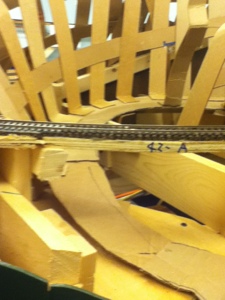So, this week I'm back upstairs at the workbench, and enjoying the sunshine and light warm breezes thru the window. Just couldn't bring myself to stay in the basement this weekend with spectacular weather like we've been having here in the midwest lately.
I did a lttle updating to my
Rio Grande Southern remaining (stuff)
page last week, but no further updates this week. I've also been reading
RGS Story v8 (which is truly an amazing work of historical research and photos!) - mostly about Mancos - and have been finding it fascinating. Most surprising was the discovery that portions of the depot, freight house and section houses still exist! In fact, here's the
freight section of the depot.
A little tidbit I discovered - the RGS had FLOWER GARDENS created at each of its depots; I finally noticed a news item about the Mancos depot noting this, and it syncs with the many photos I've seen of the depots with the little fenced-in area at the end of the depots, away from the freight sections.
I purchased a number of pre-wired 603 golden-white LEDs (from
here), and this weekend installed one for the first time. MAN - these things are tiny!
I've got a bunch of steam locomotives, painted & weathered last fall, all awaiting DCC installs. Once those is an older Sunset brass 4-8-2. Being brass, it didn't have any weight inside, and also didn't have a headlight. So - very nervously I admin - I pulled out a #60 drill and drilled a hole thru the headlight and also through the smokebox front, and ran this tiny 603 LED in there. After testing (at 12v with a 1k resistor), the effect is really amazing. I secured it with some Alene's tack glue, and plan to make a lens of Crystal Clear later.
Inside, I've been add weight to every little cranny I can find - a couple open spaces in the frame, between the wheels above the frame, and most of the front section of the boiler. Added all the wiring as well, which is hard-wired to the decoder in the tender. Only half done w/ the DCC install on this one, but it's going well so far.
I also completed a DCC install in my Bachmann 4-6-0, which is a beautiful little thing full of fragile parts and piping. After weathering, it looks great. Frankly, I was too afraid to disassemble this little fellow, so I'm using the (very poor, very yellow) stock LED for the headlight, and using the connectors between tender & loco. The color coding in the connectors didn't match NMRA or notes I found online, but I eventually figured them out. I did hardwire the decoder in the tender, after removing Bachmann's circuit board.
And finally - another first for me - I used Kadee brass coupler sprints (before the whisker couplers), and cut down the little brass plates to build up wipers for each of the 8 tender wheels. Every wheel has a wiper now, and I've got full pickup from both sides. This replaced the axle wipers that effectively gave the tender only four-wheel pickup. I'm using Neolube on the backs of the wheels, but I'm afraid of the drag on the wheels from all the wipers. I'm new at this wiper thing... but so far it seems to run ok. I did add a lot of weight to the tender.
I also found (after some forum postings at MRH) ideas to add weight to the locomotive - including on the cab floor, and (using sheet lead) on the cab roof both inside the cab, and on the apron roof over the tender floor outside.



















